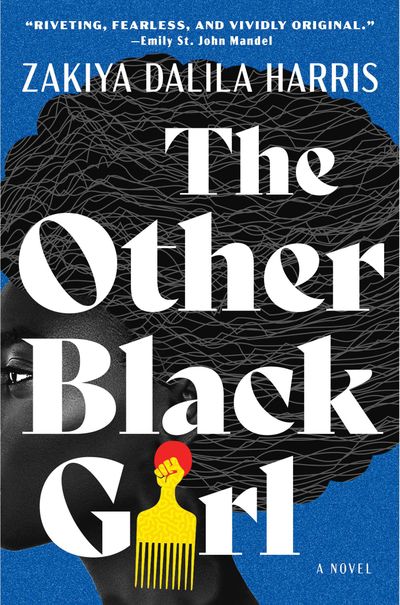‘The Other Black Girls’ is a literary mashup of ‘Get Out,’ ‘The Devil Wears Prada’

The publicity materials for Zakiya Dalila Harris’s debut novel, “The Other Black Girl,” describe the book as a literary mashup of “The Devil Wears Prada” and “Get Out.” That sets the bar high with the promise of a cultural landmark – a novel that’s timely, hilarious, witty, mildly terrifying, emotionally textured and conversant on the social and political issues that Black women face in the world and the workplace. Is the novel worth the hype? Yes. It should be at the top of your summer reading list.
The story opens in summer 2018. Nella Rogers (see: celebrated Harlem Renaissance author Nella Larsen) is in the second year of her job as an editorial assistant at Wagner Books. A University of Virginia graduate and the daughter of a college dean, Nella is privileged but still disadvantaged relative to her wealthier white peers.
Nella is hungry for a promotion and wonders if her professional ascent is halted by her race, campaign for a more diverse workplace or something else. Nella relies on two sounding boards – her best friend, Malaika, another 20-something Black girl, and her white boyfriend, Owen. The book earns its title from a new hire who disrupts Nella’s status as Wagner’s fly in the buttermilk.
Nella is immediately enraptured and perplexed by Wagner’s newest editorial assistant, Hazel-May McCall. They bond over college-educated Black girl things – literary tastes, a Zora Neale Hurston mug. But Hazel swiftly eclipses Nella, joining forces with the company’s editor in chief, Richard Wagner, and hogging the mic at a fall marketing meeting. Soon after Hazel’s start date, Nella finds a note on her desk: “LEAVE WAGNER NOW.” Is Hazel the culprit? Or are there darker forces at work?
An engaging subplot revolves around a Wagner book that hit the bestseller list in 1983 and the soured friendship between its author, Diana Gordon, and its editor, her childhood friend, Kendra Rae Phillips. Kendra flames out spectacularly after calling out, on television, the racism of the publishing industry and America in general.
Kendra’s subsequent disappearance and unrealized career ambitions haunt Nella and this text. Nella and Kendra’s story lines intersect in surprising ways as the novel transitions into a riveting thriller revolving around a covert brainwashing effort and an underground resistance movement.
One of the pleasures of “The Other Black Girl” is its unapologetic appeal to Black female readers. From references to ’90s Black culture (Janet Jackson’s braids in “Poetic Justice,” “A Different World” reruns) to ample servings of hair-related angst, conversations and plot points, Black girls will appreciate how their experiences, perspectives and quirks are centered in this novel.
At the heart of the book is Nella’s belief – confirmed by personal experience, as well as data – that the decks are stacked against Black women. Nella reflects upon “… the day she’d first learned that it would not be enough for her to simply go to college, get good grades and get the interview. That it wouldn’t be enough to simply show up to work; to simply wear the right clothes
“You had to wear the right mentality. You had to live the mentality. Be everyone’s best friend. Be sassy. Be confident, but also be deferential. Be spiritual, but also be down-to-earth. Be woke, but still keep some of that sleep in your eyes, too.”
Harris is a capable, funny writer who crafts a compelling, sympathetic and complex protagonist. Glimpsing Nella’s interior life and friendship with Malaika feels like overhearing the real thoughts and conversations of a young Black woman.
Harris creates well-written characters without pandering to Black readers or translating African American cultural shorthand for a white audience. While I enjoyed this book, the transitions between the present-day story featuring Nella and Hazel to the past narrative were occasionally awkward, and one major plot point felt underdeveloped.
And yet, I believe that the novel will assume its place as a cultural artifact that resonates especially with Black female readers. It is part of an exciting wave of recent fiction by Black millennial writers, including Alexia Arthurs’ “How to Love a Jamaican,” Kiley Reid’s “Such a Fun Age” and London-based Candice Carty-Williams’s “Queenie.”
Readers who can’t get enough of publishing workplace novels should see also Camille Perri’s debut, “The Assistants.” “The Other Black Girl” dutifully and honestly recapitulates the literary world’s debates about how to redress its long legacy of anti-Blackness.
One cannot help but note the irony of a publisher promoting a takedown of the industry. That said, it is heartening to witness a full press effort, complete with marketing, publicity and (one hopes) a large author advance, in support of a debut by a young Black writer. I hope this isn’t the last we hear from Harris, as its heartbreaking, creepy ending seems to promise a sequel.
Naomi Jackson is the author of “The Star Side of Bird Hill” and an assistant English professor at Rutgers.